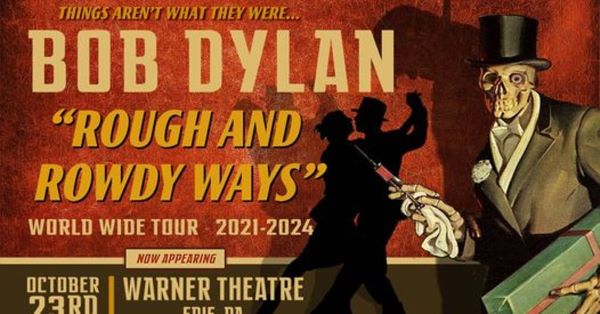Hurst course explores iconic singer-songwriter Bob Dylan

 The 2016 choice of Bob Dylan was the first time a musician and songwriter had won the Nobel Prize for Literature.
The 2016 choice of Bob Dylan was the first time a musician and songwriter had won the Nobel Prize for Literature.
It was viewed as a radical choice that divided fans and critics alike. Still, for Mercyhurst University English Professor Jeff Roessner, it was a kindred moment.
Roessner has long espoused that brilliant songwriting does indeed rise to the level of literature. He has taught numerous courses on The Beatles and their music. He’s also taught Dylan. In fact, shortly after Dylan won the Nobel Prize, he said university faculty and students celebrated with Dylan Fest, a musical celebration of the artist on campus.
As Erie prepares to welcome the 82-year-old iconic singer-songwriter to the Warner Theatre on Oct. 23, Roessner is taking the opportunity to share Dylan’s remarkable 60-year career with his students once again. He’ll take them from Dylan’s folk and protest roots, through his impact on the 1960s counterculture, his evolution as a rock provocateur, to his exploration of country, gospel, and blues music. Through it all, his ability to adapt and evolve while maintaining his artistic integrity and relevance stands as a hallmark of his career.
For Roessner, the class is personal. As a teenager playing guitar and writing his own songs, Roessner looked to Dylan for inspiration.
“He is such a profoundly important songwriter; his catalogue is so astonishing and so influential that you can’t doubt his talent or cultural significance,” Roessner said.
His course will focus on Dylan’s life and how he became what many have called “the spokesman of a generation.” With its focus on literary studies, the class asks students to pay particular attention to his lyrics, which to this day, evoke themes and emotions central to the consciousness of the country.
His songs often delved into complex social and political issues, making him a voice for change and, at times, a symbol of rebellion.
“He always seems to show up at the center of big moments—like Forest Gump,” said Roessner, who recalls that the 21-year-old Dylan performed during the March on Washington for Jobs and Freedom in August 1963 when Martin Luther King, Jr., delivered his “I Have a Dream” speech.
Amazingly, Roessner said, despite a legacy that includes 40 studio albums and counting, Dylan has had only one top single: that was in April of 2020 with “Murder Most Foul,” a 17-minute epic about the JFK assassination. He has, however, hit No. 1 eight times on the album charts.
Not surprisingly, Dylan’s songs have been covered by many other artists, who took his songwriting, lyricism, and storytelling to the top of the popular music charts.
In 1963, Peter Paul & Mary reached No. 2 in the charts with this anthemic protest single:
Blowin’ in the Wind
How many roads must a man walk down
Before you call him a man?
How many seas must a white dove sail
Before she sleeps in the sand?
Yes, and how many times must the cannonballs fly
Before they're forever banned?
The answer, my friend, is blowin' in the wind
The answer is blowin' in the wind.
And in 1965, The Byrds scored a No. 1 single with one of Dylan’s most iconic songs, Mr. Tambourine Man, giving Dylan’s poetic lyrics a jangling, electric setting and helping launch the entirely new genre of folk rock.
Mr. Tambourine Man
Hey, Mr. Tambourine Man, play a song for me
I'm not sleepy and there is no place I'm going to
Hey, Mr. Tambourine Man, play a song for me
In the jingle jangle morning I'll come following you.
Admittedly, Roessner said, covering the prolific career of a “folk singer, poet, provocateur, sixties icon, chameleon, and artist,” will take some doing in the semester’s 12 short weeks, but one thing is certain: “I want my students to understand how a masterful songwriter crafts his lyrics and melodies and themes to achieve what we can only call ‘great art’.”